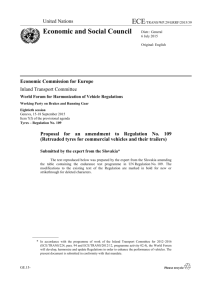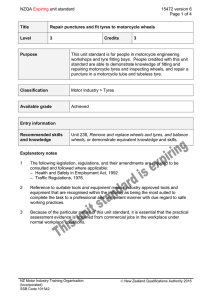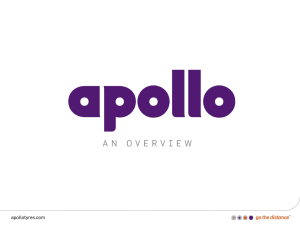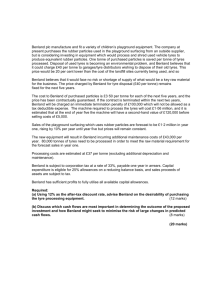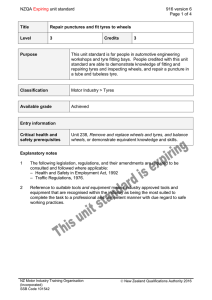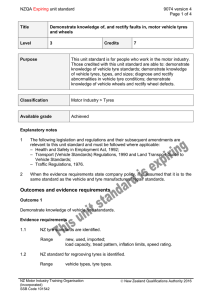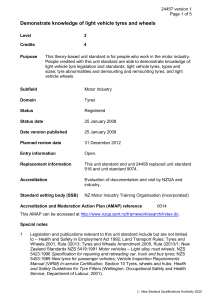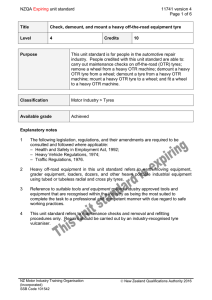Repair punctures and fit tyres to motorcycle and all-terrain vehicle
advertisement
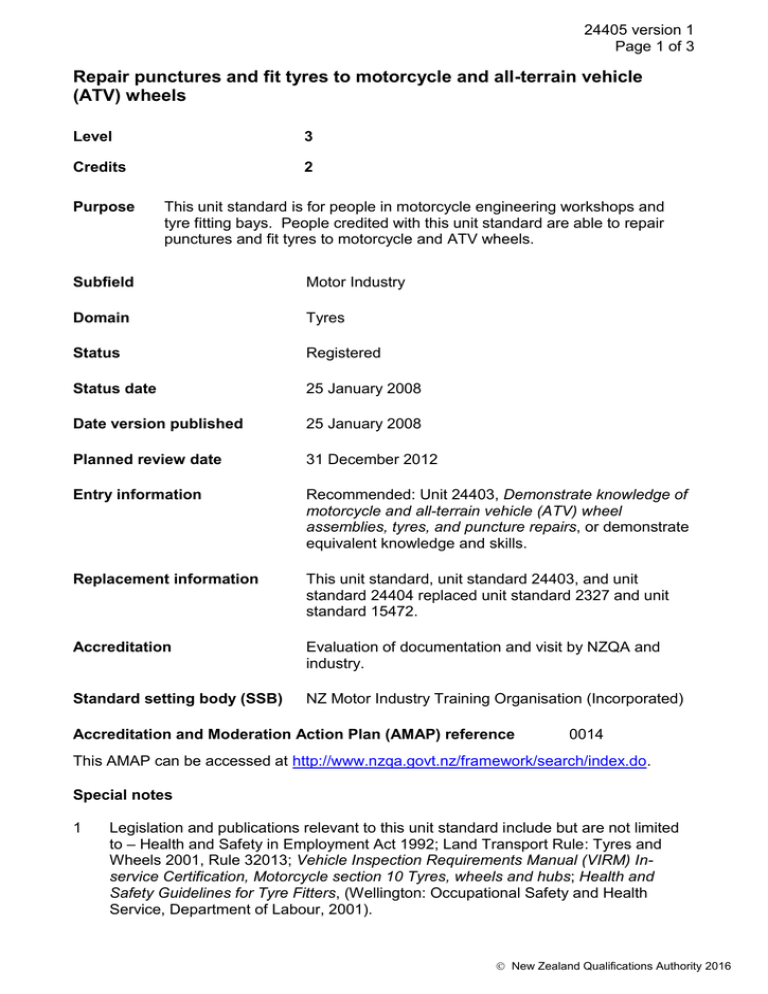
24405 version 1 Page 1 of 3 Repair punctures and fit tyres to motorcycle and all-terrain vehicle (ATV) wheels Level 3 Credits 2 Purpose This unit standard is for people in motorcycle engineering workshops and tyre fitting bays. People credited with this unit standard are able to repair punctures and fit tyres to motorcycle and ATV wheels. Subfield Motor Industry Domain Tyres Status Registered Status date 25 January 2008 Date version published 25 January 2008 Planned review date 31 December 2012 Entry information Recommended: Unit 24403, Demonstrate knowledge of motorcycle and all-terrain vehicle (ATV) wheel assemblies, tyres, and puncture repairs, or demonstrate equivalent knowledge and skills. Replacement information This unit standard, unit standard 24403, and unit standard 24404 replaced unit standard 2327 and unit standard 15472. Accreditation Evaluation of documentation and visit by NZQA and industry. Standard setting body (SSB) NZ Motor Industry Training Organisation (Incorporated) Accreditation and Moderation Action Plan (AMAP) reference 0014 This AMAP can be accessed at http://www.nzqa.govt.nz/framework/search/index.do. Special notes 1 Legislation and publications relevant to this unit standard include but are not limited to – Health and Safety in Employment Act 1992; Land Transport Rule: Tyres and Wheels 2001, Rule 32013; Vehicle Inspection Requirements Manual (VIRM) Inservice Certification, Motorcycle section 10 Tyres, wheels and hubs; Health and Safety Guidelines for Tyre Fitters, (Wellington: Occupational Safety and Health Service, Department of Labour, 2001). New Zealand Qualifications Authority 2016 24405 version 1 Page 2 of 3 2 Land Transport Rules are produced for the Minister of Transport by Land Transport New Zealand. These rules are available online at http://www.landtransport.govt.nz/rules/. The VIRM is published by Land Transport New Zealand and is available online at http://www.landtransport.govt.nz/certifiers/virm-in-service/index.html. Health and Safety Guidelines for Tyre Fitters is available online from the Department of Labour website http://www.osh.govt.nz/order/catalogue/106.shtml. 3 Definitions Company requirements refer to instructions to staff on policy and procedures which are documented in memo or manual format and are available in the workplace. These requirements include but are not limited to – company specifications and procedures, work instructions, manufacturer specifications, product quality specifications, and legislative requirements. Service information may include but is not limited to – technical information of a vehicle, machine, or product detailing operation; installation and servicing procedures; manufacturer instructions and specifications; technical terms and descriptions; and detailed illustrations. This can be accessed in hard copy or electronic format and is normally sourced from the manufacturer. Suitable tools and equipment means industry approved tools and equipment that are recognised within the industry as being the most suited to complete the task in a professional and competent manner with due regard to safe working practices. Elements and performance criteria Element 1 Repair punctures and fit tyres to motorcycle and ATV wheels. Performance criteria 1.1 Safe working practices are observed throughout the task in accordance with legislative requirements. Range personal safety, safety of others, motorcycle safety, workshop safety, environmental safety, tools and equipment safety. 1.2 Suitable tools and equipment are selected and used to enable tyres to be repaired in accordance with tyre company requirements. 1.3 The wheel and tyre assemblies are inspected, and their condition determined, in accordance with service information and legislative requirements. Range 1.4 pressure loss, tyre wear, wheel damage, tyre impact damage, casing failure. Demounting and mounting tyres are carried out in accordance with the rim type. Range may include but is not limited to – cast type, composite type, pressed steel type, split rim type, spoke type. New Zealand Qualifications Authority 2016 24405 version 1 Page 3 of 3 1.5 The disassembled wheel and tyre assembly components are inspected, and their suitability for repair is determined in accordance with company requirements. Range 1.6 inner casing damage, beading damage, cleanliness of surfaces, compliance to legislation, valve, wheel rims, rusting, wheel damage, inner liner, tube damage, rim locks and security devices. Punctures are repaired to tyre manufacturer recommendations and puncture repair kit instructions, depending on the type of tyres, and size and location of the punctures. Range may include but is not limited to – patches and plugs to the tyre without the application of heat using chemical and adhesive solutions, patches and plugs vulcanised in place by the application of localised heat with a spot vulcaniser, tubes repaired with a cold vulcanising repair kit, tubeless tyres, tubeless rims, compatibility of rim type to tyre. 1.7 The size and type of replacement tyres and tubes are selected to conform to that of the wheels, and to the motorcycle or ATV applications and customer requirements. 1.8 Wheel and tyre assemblies are balanced in accordance with equipment manufacturer instructions. Range static, dynamic. Please note Providers must be accredited by NZQA, or an inter-institutional body with delegated authority for quality assurance, before they can report credits from assessment against unit standards or deliver courses of study leading to that assessment. Industry Training Organisations must be accredited by NZQA before they can register credits from assessment against unit standards. Accredited providers and Industry Training Organisations assessing against unit standards must engage with the moderation system that applies to those standards. Accreditation requirements and an outline of the moderation system that applies to this standard are outlined in the Accreditation and Moderation Action Plan (AMAP). The AMAP also includes useful information about special requirements for organisations wishing to develop education and training programmes, such as minimum qualifications for tutors and assessors, and special resource requirements. Comments on this unit standard Please contact the NZ Motor Industry Training Organisation (Incorporated) info@mito.org.nz if you wish to suggest changes to the content of this unit standard. New Zealand Qualifications Authority 2016

